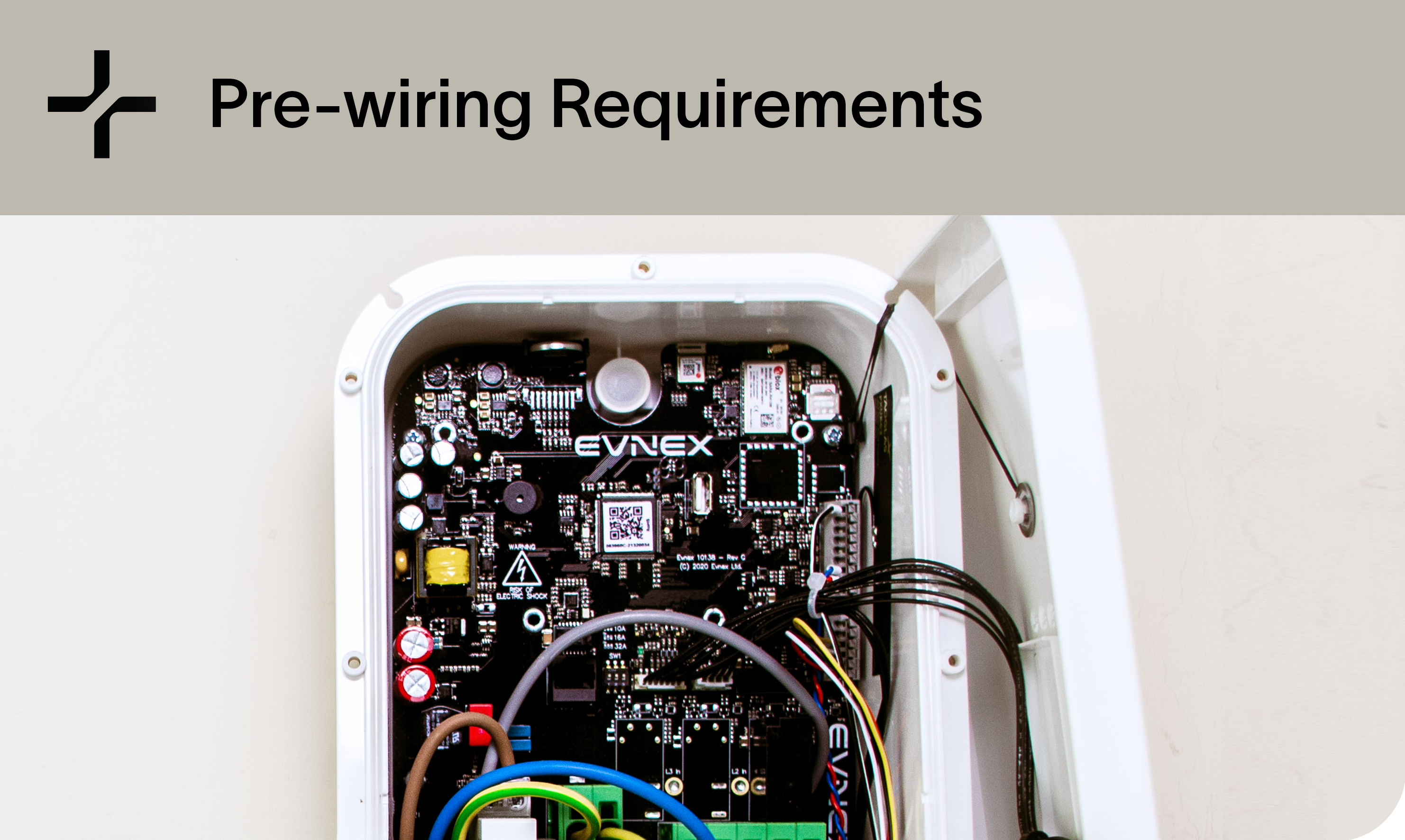Pre-wire Requirements
For the installation of Evnex E and X series Smart EV Chargers.

Please NoteThis document is intended to give guidance around pre-wiring requirements for the installation of Evnex E2 and X-series Smart EV Chargers in a residential or light commercial setting.
Cable/Switchboard Requirements
7.4kW Single Phase – Residential
- Customer/Electrician to run a 32A 2C+E dedicated supply cable and a 1-pair or 3-pair (depending on number of phases to be monitored*), overall screened instrumentation cable, ≥0.5mm² and appropriately rated at the max. Voltage present in the switchboard (≥230/400V), between the main switchboard and the charger location. Consult with your electrician regarding supply cable size, (6mm² minimum).
- At each end, there must be a 1m cable length for the termination of the cable.
- It is not necessary to separate the instrumentation and supply cables.
- Cables must be installed to current standards and regulations.
- To avoid additional switchboard enclosures during the installation of the charger, at least 2 spare ways should be made available in the switchboard for the circuit protective device required for the charger.
*Please note, only X-series chargers can monitor multiple phases.
22kW Three Phase – Residential
- Customer/Electrician to run a 32A 4C+E dedicated supply cable and a 3-pair, overall screened instrumentation cable, ≥0.5mm² and appropriately rated at the max. Voltage present in the switchboard (≥400V), between the main switchboard and the charger location. Consult with your electrician regarding supply cable size, (6mm² minimum).
Important: Cable sizing for three-phase mode 3 chargers must be calculated as an unbalanced load (or single phase) since many vehicles will charge at single phase only.
- At each end, there must be a 1m cable length for the termination of the cable.
- It is not necessary to separate the instrumentation and supply cables.
- Cables must be installed to current standards and regulations.
- To avoid additional switchboard enclosures during the installation of the charger, at least 4 spare ways should be made available in the switchboard for the circuit protective device required for the charger.
Connectivity
- Where mobile reception for the integral SIM card or Wi-Fi connectivity is poor or non-existent at the charger location, a Wi-Fi extender must be installed prior to the installation. The charger cannot be commissioned or used without an internet connection.
- For X-series only, connection via an ethernet cable is possible as an alternative. The cable must be run between the charger location and the router, network switch, or data cabinet. This cable must be physically separated from the supply cable.
Charger Position & Cable Entry:
- Standard charging cables are 5m in length, however 8m options are available. For universal (socketed) chargers, even longer options might be available.
- The recommended installation height of a wall-mounted charger is ~1.2m from the floor/ground.
- When running cables through a wall cavity, the recommended cable exit point from the wall is 1.1m directly to the left of a stud or fixing, via a vertically mounted flush-box. The charger should not be fixed to GIB (plasterboard) alone.
- Where an additional isolator switch is to be installed, adjacent to the charger, consider the positioning of the isolator when installing the cables in relation to the charger. The supply cable must be run to the charger position described above via the isolator switch position. Please allow at least a 0.5m loop of cable at the isolator location for termination.
- Where cabling is installed via conduit or capping, ensure cable entry positions of the charger are accurate. Drilling the casing of the charger outside of the dedicated entry points will void the warranty.
- Universal (socketed) chargers or chargers that are able to be struck by vehicles, must be installed above 0.8m from the finished floor/ground level.
Confirmation/Verification:
Where Evnex is to complete the charger installation, testing and commissioning, following a pre-wire by a third party, the following are required prior scheduling your installation:
Wiring by a registered electrician:
- A copy of the Electrical Certificate of Compliance to Evnex, referencing the cable installation as compliant.
- Photo showing charger location and cables (incl. loop for isolator switch, where required).
- Photo of overall switchboard, showing all devices.
Wiring by others:
- Photo of the charger location (and isolator where required) including cables.
- Photos of the cables installed in walls, roof, or floor space where possible.
- Photo of printed cable type and size for both, supply and instrumentation cable.
- Photo of the switchboard showing spare ways for the charger protective devices.
- Where the cables have been buried, we require photos showing the cables within the trench and the depth of the trench of at least 0.6m (please show this with a tape measure in the photo). We also require a photo showing the trench approximately half back-filled with electrical warning tape placed in the trench.
Updated about 2 months ago